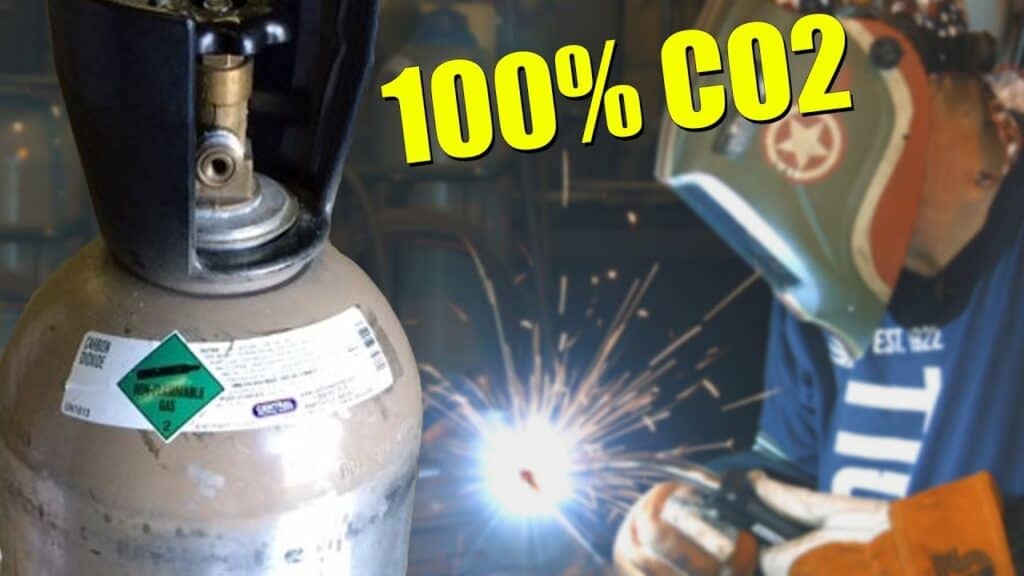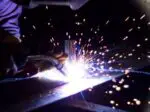AH! I know that MIG welding can be a very interesting process. Once you are into it, you can see how much of an incredible scope that it holds for the welders to create wonderful welds.
 Well, a major part of this is contributed by the shielding gas used for MIG weld. And today, I am going to tell you a little about one of the major shielding gases used in MIG weld- CO2.
Well, a major part of this is contributed by the shielding gas used for MIG weld. And today, I am going to tell you a little about one of the major shielding gases used in MIG weld- CO2.
So, does CO2 hold a lot of advantages for MIG weld?
CO2 has its benefits for MIG weld. Carbon dioxide is a highly preferred shielding gas for MIG welding and is considered an essential element for welding of metals like stainless steel and mild steel. Low cost is a major reason why CO2 is preferred in MIG weld. But, this gas comes with its own disadvantages as well.
Read further to know about CO2’s role in MIG weld…
Why CO2 is considered a good shielding gas for MIG?
CO2 is one among the most used reactive gases used in welding. It is not just in MIG; even TIG uses CO2 in certain rare cases to get very specific results. CO2 has been used in welding since the very beginning when welding began to be done with machines. There are a few reasons why CO2 never loses its importance in welding and is still quite popular in the welding world.
The reasons for this are:
1.) Improved penetration: CO2 is known for its ability to give excellent penetration into the metal. Its properties easily help to create heat and therefore the electrode is very much in its form when CO2 is used for shielding. Therefore penetration becomes easier even for hard metals. A high arc voltage is very much necessary for a smooth weld.
2.) Cost benefit: CO2 is available dirt cheap. When compared to other gases used, CO2 is easily available at lower cost. Even though other gases like helium, argon, oxygen, hydrogen etc are used for MIG welding, because of the cheap rate of CO2; it is usually preferred over other gases.
3.) Better shielding characteristics: True. CO2 can give better welding characteristics because of its heavy nature. This gas is heavier than oxygen or helium thereby giving substantial support to the welding process.
It is this weight that helps in giving a good shield for the weld thereby protecting the weld pool from any contamination that can result from contact with the atmosphere.
See also: Can we use MIG gas for TIG welding
Can I use CO2 mixed with other gases to MIG weld?
Yes, you can. And that is how C25 comes into play in MIG weld. C25 is the mixture of Carbon Dioxide and Argon in 25:75 ratios. This carbon mix is used in MIG weld to get a stable arc that can help in the weld.
When pure CO2 is used there are certain problems that may arise which the presence of Argon can solve. This is one among the main combinations of gases used in MIG weld.
Comparison of MIG weld characteristics with C25 or CO2
| Pure CO2 | C25 | |
| Cost | Less costly | Costly |
| Arc Stability | Weak arc stability | Good arc stability |
| Spatter amount | More | Less |
| Range of metal quality covered | Low | High |
Comparison of C25 with CO2 in terms of cost and specifications
| 20# CO2 | 80CF C25 | |
| H x W (in.) | 26 x 8 | 35 x 7 |
| Full Wgt. | 45 lbs. | 56 lbs. |
| Volume | 174.8 cf | 80 cf |
| Time@20cfh | 8.8 hrs. | 4.0 hrs. |
| Initial Cost | $150 | $315 |
| Initial $/hr | $17.25 | $79 |
| Refill Cost | $35 | $75 |
| Refill $/hr | $4 | $18.75 |
See also: Can I TIG weld mild steel with Pure Argon
What are the pros and cons of using pure CO2 for MIG weld?
So just like anything else using pure CO2 has its pros and cons in MIG weld. Even when CO2 is said to be cheap, there are reasons why people often go for MIG mix to do the welding rather than with 100% CO2.
The pros of using pure CO2 in MIG weld are as follows:
1.) Better Joint penetration: As mentioned about CO2 in general, the higher the presence of CO2 higher will be the penetration. Therefore when you are using pure CO2 the penetration will be higher.
For joint penetration, pure CO2 works the best as it transfers high voltage strength to the electrode making it ready to penetrate through even hard metals.
2.) High welding speeds: As the electrode is well charged and penetration also happens smoothly, the speed of the weld will also be high. With better weld, you would not have to take a lot of time to finish the work. Moreover, for the welder, the process might be less time taking.
3.) Shielding effectiveness: With 100% CO2 you get a better shielding cover for your weld. Due to the heaviness and density that the gas has, it can give a good protection to the weld pool.
Unlike other gases like helium or oxygen, this gas can make a clear separation between the weld and the atmosphere. Thus the shielding effectiveness is pretty high when you use 100% CO2. This is an added advantage if you are working in a windy area.
4.) MIG Gun Duty Cycle: When you use 100% CO2, the duty cycle of a MIG gun is comparatively more than when a C25 is used. With C25 the machine needs to deal both with Argon and CO2 which requires more energy.
5.) Oxidation risk is less: Even though CO2 is reactive in nature, it is not too prone to cause oxidation of metal like oxygen. Rather, CO2 can help to an extent from getting oxidized easily. But that does not mean you can completely rely on CO2 because it is by nature a reactive gas after all.
Now let’s see the other side of the coin- the cons:
1.) Reduces arc stability: Yes, with pure CO2 the arc stability is quite less. The strength of the arc is pretty weak here and this can result in a weld not aesthetic in nature. With poor arc stability, the process can be quite troublesome for the welder.
2.) Not good for thin metals: Pure CO2 can give a very good penetration and therefore can help you to deal with hard metals. But, what about thin metals? For thin metal this boon of pure CO2 converts into a bane. With high penetration risk, pure CO2 is quite risky for thin metals as they can easily get ruined.
3.) More spatter: With pure CO2 you should be ready for a messy welding procedure. As the arc stability is pretty less, it will result in more spatter than you do a weld with other gases.
One thing that you can do to avoid this is finding the sweet spot between the voltage and the wire speed. This can give you less spatter even with pure CO2. Also, keeping the arc length shorter can help in reducing spatter.
Characteristics of CO2 gas shielded welding machines
Some of the common characteristics of a CO2 MIG welding machine are :
-
-
- High speed of weld gun
- The current arc can spray transition will be small
- Has a compact and aesthetic look
- Welding is possible from all position
- Welding can be directly done without baking if the welding wire is wet. Also the pulse will be uniform and weld can be done without pores.
- When welding happens at a low current, you won’t be able to see a ball at the tip of the arc and hence the arc and the molten pool are well controlled.
- The depth of penetration will always be larger than other cases
-
Why is CO2 considered the best gas for MIG weld of mild steel?
Mild steel is a metal with very low carbon content. They are therefore very thin and can be easily welded. But, this low carbon content can be a bane in regards to oxidation. The lower the carbon content the higher will be the risk of oxidation.
Another major issue with mild steel in MIG weld is that inert gases like Argon and Helium can lessen the arc stability thereby resulting in bad weld with a huge potential for undercuts. Undercuts are the grooves on the base metal that happen along the length of weld metal.
Due to these reasons, CO2 and C25 are the most commonly used gases for carbon steel along with mixtures of other gases like argon or oxygen.
Carbon dioxide is therefore considered as the best gas to MIG weld mild steel as the risk of getting a bad weld is too low given there is a mixture of other gases along with it.
For instance, the presence of Argon as a mixture along with CO2 will give a better shielding to the weld. Thus C25 is more effective than pure CO2 in MIG welding mild steel.
When is CO2 used in tri-mix for MIG weld?
Now, a tri-mix is where CO2 is mixed with two other gases for MIG welding. An example of tri-mix is the CO2, helium and argon. Helium would come around almost 90%, the rest 10% will be divided between CO2 and argon in the ratio 1:3. Another popular tri-mix combination is helium, argon and oxygen.
A tri-mix is sometimes used in the MIG weld of stainless steel. Each gas in this combination is used with a specific aim. While helium can increase the heat capacity of the arc, oxygen will help in the arc stability and in getting a better penetration.
Unlike carbon steel, stainless steel has a considerable content of chromium that prevents oxidation. The minimum amount of chromium will be 10.5% by mass. This presence of chromium is enough to prevent oxidation that can happen with the involvement of oxygen in tri-mix.
However, gases like helium and CO2 demands high voltage to maintain a stable arc and also helium is expensive as well. This makes a tri-mix with these gases less preferred by welders. Rather a combination of 98% Argon with 2 percent CO2 is used for MIG welding stainless steel.
End Note
Low cost makes CO2 a popular choice for MIG weld. With CO2 you do not have to worry about the process going way beyond your budget. However, you need to take your own precautions to avoid the risk of ruining a good weld while using this gas.
Bye friends!
Hope to see you in another one of my blogs!







